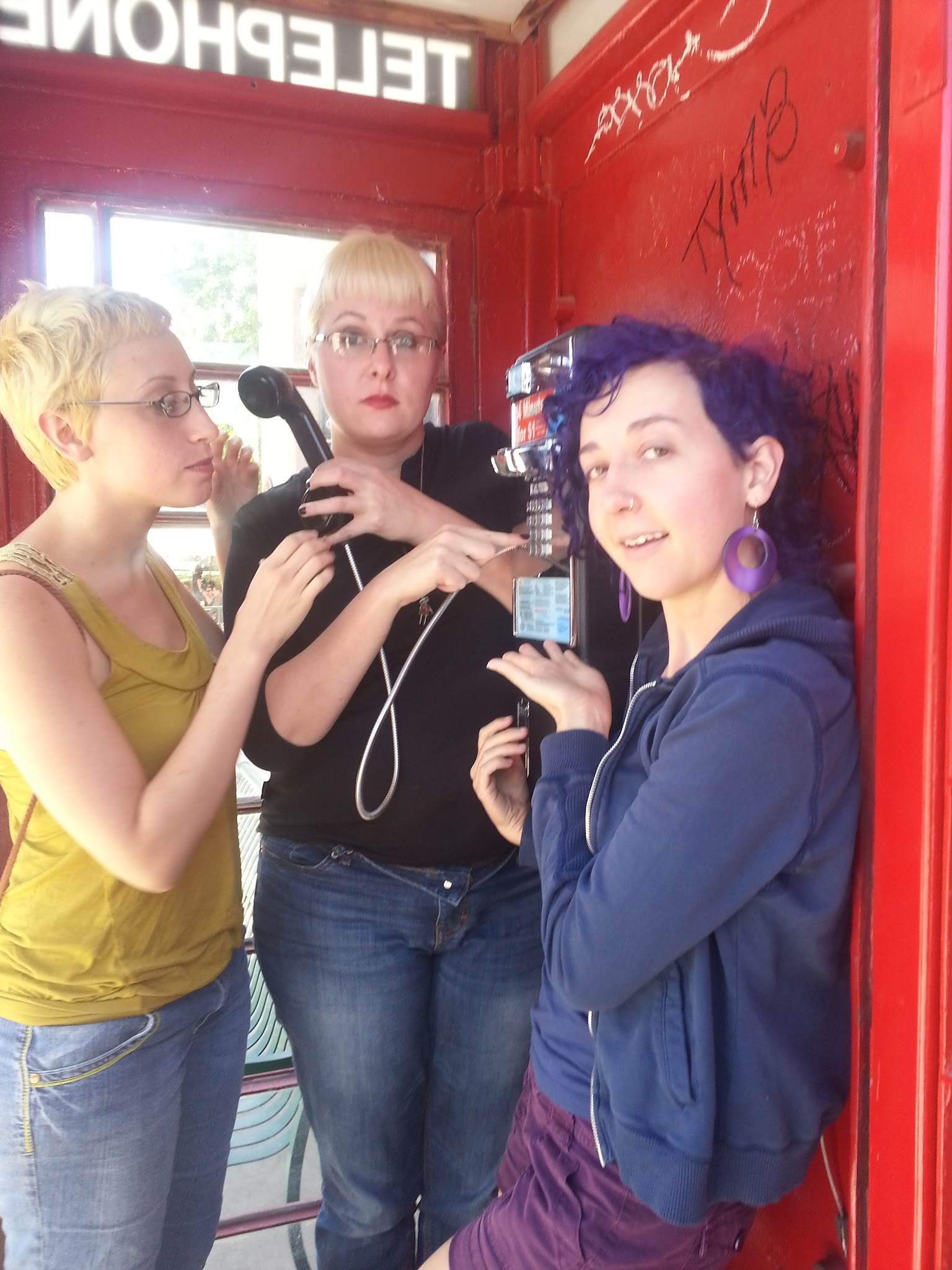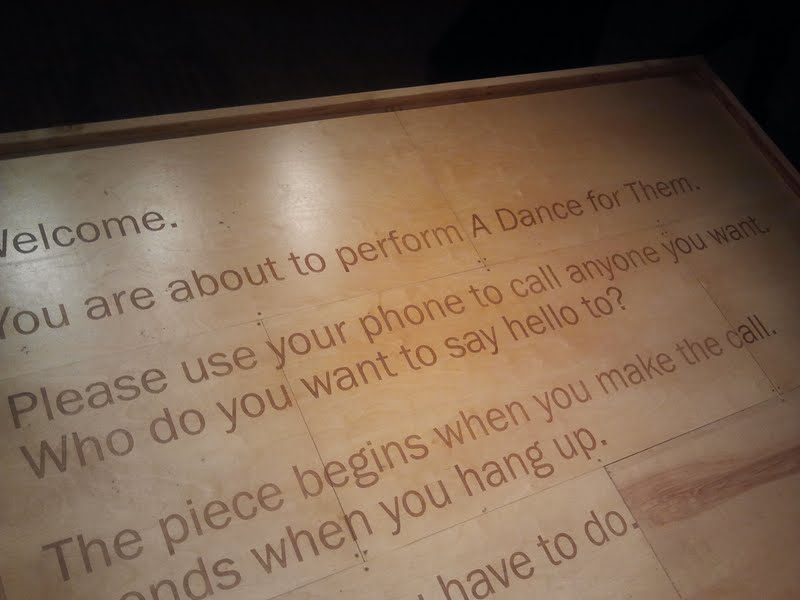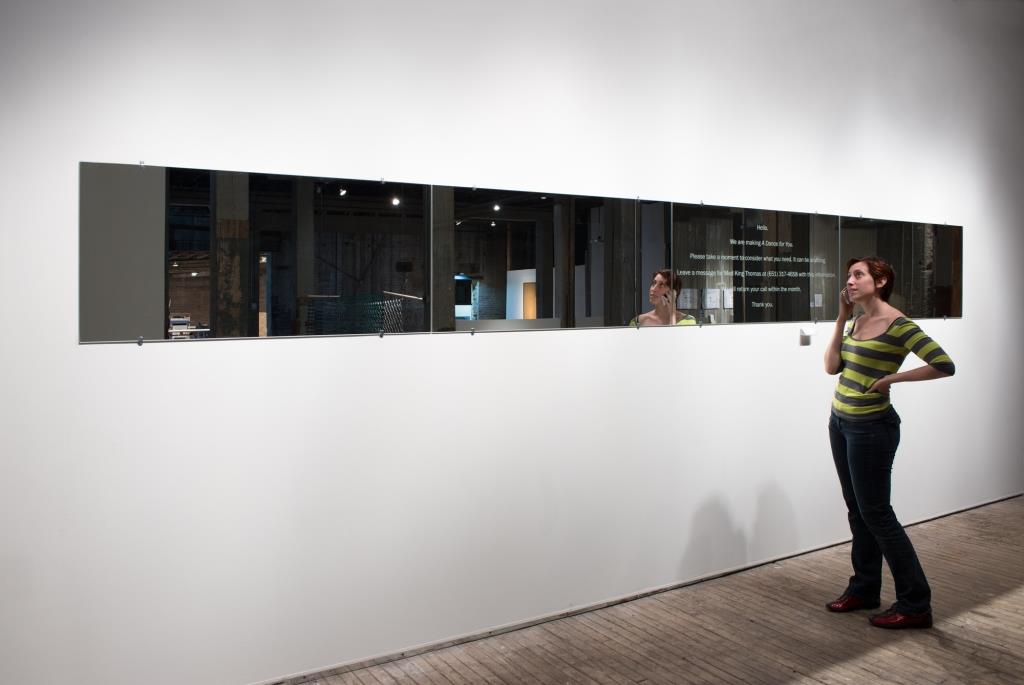Reach Out and Touch Someone
On the boundaries of community, both intangible and concrete, the lonesome freedoms afforded by 21st century phone culture, and one deceptively simple question: What, exactly, constitutes a dance?




The other spectators seem to feel the same; they’re not so much spectators as momentary observers. By this I mean that they give Thomas a bit of privacy for her call, looking at her now and again but not steadily, like strangers in a coffee shop. Actually, given the way I at least eavesdrop on people in coffee shops, perhaps we’re giving her more privacy than you would get for an average phone call. The elevated stage acts as a screen.
Beyond the stage, a horizontal strip mirror — at least ten feet long, head-and-shoulders height — garners more open stares. Here, we’re invited to think about what we need in the way of a dance and phone our needs in to the MKT hotline. Somehow, I can’t do this right now; the buzz of an art opening—dressed-up strangers, noise, laughter, drinks—jazzes my neurons enough. I don’t seem to be alone in this; people are too busy looking at each other to get out their cell phones and call for a dance.
I skim through the rest of Artists on the Verge and return to the MKT stage, which is now empty. Okay, I’m going home. But first, let me fill you in on the other art objects/experiences on view. In Anthony Warnick’s The Library, you’re invited to read, check out books, perhaps even assist in the ongoing process of printing and binding new books. Chris Houltberg uses a bizarre questionnaire to build a personal(ish) mini-experience inside his Profile Cube; on opening night, the rules of queuing and entry rapidly fall apart, with strangers bursting backwards into other people’s profile results. Sarah Julson offers maps to guide readers along various paths around her installation The Way. Finally, Asia Ward’s haunted house/Fantastic Voyage installation in the basement invites exploration. (For more on all these, see Sheila Dickinson’s review of the exhibition for mnartists.org.)
Question: Are these also dances?
MY PHONE DANCE (1)
I return to the Soap on a Saturday afternoon, determined this time to have the experience, do the thing. Funny how much art now demands this squaring of the shoulders. Or maybe it all does and always had—but I notice it more with participatory installations, in which my experiencing of the art becomes a performance that I am also audience to.
I go up on stage for the first time and realize that there are instructions in the floor (beautifully burned into the soft pale pine in an airy sans serif): I am to call someone. The dance ends when I hang up. So I call my friend Corinne, who lives near Toronto and who I’ve been meaning to call for a couple of months now. The phone rings. There’s hardly anyone in the Soap, and I snare only a few sidelong looks, a little “What’s she doing up there?” but no lasting stares. The phone keeps ringing, and then the answering machine picks up. Of course, Corinne is not home. No one is ever home these days. I leave a message, walking around the stage in, I realize, precisely the same way Thomas did on opening night—head down, placing my feet carefully, mindful of the words I’m stepping on. When I’m done with my message, I pause a moment. This was a very short dance—less than two minutes—so I feel that I have cheated. On the other hand, the directions on the stage tell me that my dance is now over. I leave the stage.
Five minutes later, Corinne calls back. I consider whether I should re-ascend the stage, but I decide not to; this is not in the contract created by the message on the stage. So I sit down in Sarah Julson’s exhibit, on a low concrete wall. Here, I am doubtless in the way (and in The Way). Steps lead to the wall, and I’m sure the maps instruct visitors to pass through this space I’m mindlessly blocking. Yet I seem to have become a more successful performance piece by plunking myself down here. People are looking at me, smiling. Of course I’m also smiling, and laughing, and making jokes, because I’m talking to my friend. Corinne and I talk for half an hour or so about life, art-making, and the overlap between the two.
After I hang up, I walk to the mirror, look at myself for a moment (I look familiar), and take a card. Outside the Soap Factory, I call the number and ask for “a vacation,” and then “a hoedown.” This last item emerged without premeditation. There’s something lovely about being asked what you want, sending your needs into the universe, not knowing how or when the answer will come back.
_____________________________________________________
Whenever you do something under the heading of ART, the activity feels entirely different—in quotation marks, if you will. Try it for yourself: Mow the lawn as art, or, the next time you’re in a line and you really don’t want to be, decide that the line is art.
_____________________________________________________
PHONE TAG
Then—a month elapses.
MKT calls me, but I’m never there. That is, I’m pretty much always there—it’s my cell phone, which I always have on me—but I don’t hear the call, or I’m teaching, or I’m eating dinner, or, I have to admit, I just don’t want to pick up. Does anyone pick up the phone now? I hardly ever answer my phone. I text or email, or, with out-of-town friends like Corinne, I schedule phone calls. Out of desperation, MKT—more specifically, Tara King—and I take to scheduling. But one or the other of us blows appointment after appointment.
We’re playing phone tag, and that makes me laugh. Is phone tag a dance? Is phone tag physical? Would it need to be physical to be a dance? All right, that question doesn’t interest me at all, but here’s the thing: Whenever you do something under the heading of art, the activity feels entirely different—in quotation marks, if you will. You can try this yourself: Mow the lawn as art, or, the next time you’re in a line and you really don’t want to be, decide that the line is art.
I know it’s old hat, this duck-rabbit life-art switch, but here it calls phone culture profoundly to my attention. I talk to strangers to get my North Carolina utilities turned on; I talk to my parents; occasionally my partner and I talk on the phone. But when we talk on the phone, it’s because something has gone wrong or we’ve confused each other. Our playful contact goes on by text message. If, when I was younger, the telephone was a lifeline, a source of amusement and events, contact and even love, apparently now the telephone is a lonely place.
MY PHONE DANCE (2)
7/22/2013. At last it works: King calls me and I’m there and I pick up the phone. I can hardly believe it. She tells me she will transfer me, makes a doot-doot noise, and then her voice, softened, soothing, and a bit tired, comes on the line and begins to tell me very nice things about myself and about this moment. “Talking to you is the best part of my day,” she says. She sounds like she means it. “I am happy because I am on the phone with you.” I am walking around in post-industrial Durham, NC, glancing into a warehouse turned housewares shop that sells the most beautiful weathered Persian rugs. I notice they’ve turned on the chandeliers. I see a plant I want to investigate more closely, so I take a detour. I told King I would be walking, so I feel a little guilty as I come to a halt before a tub of herbs, but just then she says, “You are doing a good job.” I keep expecting King to direct me to do something, but she never does. Instead, the overall drive of the voice-over is permission. It’s short and repeats, this time with a slightly different emphasis (still, somehow, I think it’s a recording). I listen perhaps three times.
I’m watching grass wave in the wind when my partner arrives. I let him listen and he, after a moment, asks me if this is Ring Ring Poetry—Cole Sarar’s recent phone poetry project, in which I participated. It’s not, and yet I think my drive for the poem I recorded was similarly about the person at the other end of the line: What would someone need to hear?, I was thinking. The poem was set in a particular place (in my case, Lake of the Isles) and included directions for the reader.
Again, the crossover question: What makes a dance?
A DEBRIEFING
A couple of days after my phone dance, I talked to Tara King again to find out how the project worked. Briefly, there were four basic dance structures: the walking dance, the jumping dance, the jumping dance plus small dance (specifically, Steve Paxton’s Small Dance), and the imagine dance. MKT sorted the requests for dances (about 75) into these categories based on what the caller seemed to need: requests for reassurance or confidence got the walking dance, requests for silliness got the jumping dance (with the jumping-plus-small dance being a much narrower category), and the imagine dance worked as a catch-all, covering requests that involved injuries, nostalgia, or specific places.
I got the walking dance. After hearing about the imagine dance, I sort of wish I’d had that one; it’s a world-ending, body-clearing sort of ritual. But I suppose I have to trust the choreographers to give me the dance I need … surely an odd thought, as if MKT had become shamans. And, in fact, King uses the word “diagnose” at one point in our conversation.
Within the basic scripts set by these categories, dances were customized to individual requests, then delivered live by one of the three members of MKT. How did this go? Months of phone tag ensued, plus ample phone awkwardness: “Maggie Thomas? I don’t know who that is,” one recipient said. And “phone calls are horrible,” King says; of the trio, only one actually likes to talk on the phone. Of course, that was part of the purpose of the project: “How can we make phones suck less?” Success was mixed: MKT couldn’t tell what people did with the dances because most ended with the recipient hanging up the phone—except when, even more awkwardly, people talked back to them. Still, King says of the dance I got, “I really like giving it.” Are the phone calls a performance? Yes, King says; “I definitely get stage fright every time in the same way” as when she performs in person.
As the above suggests, another purpose emerged as MKT’s phone dances went on: to make a space in which to … not so much decide but discuss meta-questions of dance. As King asks, “Is dance shared physicality? Or is it in your mind?”—the dance you imagine as you watch. “Or is it the oral history?”—the history that backs up the steps, the context in which they have meaning.
Another aim was to think about what community can be when it’s not physically immediate — how a dance can be meaningful when it’s not local — in preparation for a larger project they’re working on, about home. MKT excels at satire, but this sort of sincerity is bit out of their comfort zone. We’re a long way from the topless suffragettes of their 2011 Momentum commission. So, for the utter sincerity of Phone Dances, they enlisted Marcus Young, an expert at affecting and non-cloying public art, as their mentor. And then, says King, “We ran forward with the total earnestness of it.”
_____________________________________________________
About the author: Originally from Tallahassee, Lightsey Darst is a poet, dance writer, and college instructor. Her manuscript Find the Girl was recently published by Coffee House; she has also been awarded a 2007 NEA Fellowship. She writes a regularly on a variety of subjects for mnartists.org.